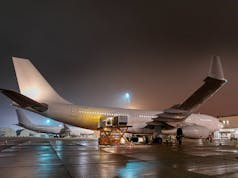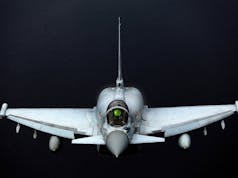A medium-range ballistic missile was air launched by a US Air Force C-17 over the Pacific Ocean in order to test the THAAD weapon system.
Capt. Stephen Koether, 418th Flight Test Squadron, C-17 experimental test pilot said:
“High altitude, heavy weight airdrop is something we’re doing a lot of here at Edwards, supporting not only MDA, but NASA with the Orion capsule drops that we’ve been doing out at Yuma. Dropping something that heavy at that high of an altitude is not trivial, and the test center, specifically, is getting very good at those unique missions.”
MDA Director Lt. Gen. Sam Greaves said:
“In addition to successfully intercepting the target, the data collected will allow MDA to enhance the THAAD weapon system, our modeling and simulation capabilities, and our ability to stay ahead of the evolving threat.”
According to a press release:
“Soldiers from the 11th Air Defense Artillery Brigade conducted launcher, fire control and radar operations using the same procedures they would use in an actual combat scenario. Soldiers operating the equipment were not aware of the actual target launch time.
This was the 15th successful intercept in 15 tests for the THAAD weapon system.
The THAAD element provides a globally-transportable, rapidly-deployable capability to intercept ballistic missiles inside or outside the atmosphere during their final, or terminal, phase of flight. THAAD is strictly a defensive weapon system. The system uses hit-to-kill technology where kinetic energy destroys the incoming target.
The mission of the Missile Defense Agency is to develop and deploy a layered ballistic missile defense system to defend the United States, its deployed forces, allies and friends from ballistic missile attacks of all ranges in all phases of flight.”
The THAAD system located at Pacific Spaceport Complex Alaska in Kodiak, Alaska, detected, tracked and intercepted the target.














Cost effective alternative to trident equipped submarine?
If it was, it wouldn’t be feasible with the amount of C-17s we have.
No.
This was experimented with in the 60’s. There was also to be a ballistic missile built specifically for air launch – Skybolt. It was cancelled, leading directly to the UK getting Polaris.
It loses part of the deterrence.
The idea of trident is that the other side knows that we could still counter attack even after they first strikes us. I would reason that any first strike against the UK, would take out the army/airforce bases (not many targets now a days), which would mean all the c17’s would go with them.
However trident would be quietly hiding somewhere in the ocean, in theory untrackable.
Exactly
In theory ?
CASD is the most effective solution, but at a cost exceeding £40bn is it affordable?
Our conventional forces are being stripped bare to pay for it, given the defence budget is limited CASD maybe not be a price worth paying.